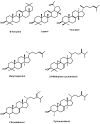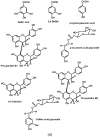Ethnobotanic, Ethnopharmacologic Aspects and New Phytochemical Insights into Moroccan Argan Fruits
- PMID: 29084170
- PMCID: PMC5713247
- DOI: 10.3390/ijms18112277
Ethnobotanic, Ethnopharmacologic Aspects and New Phytochemical Insights into Moroccan Argan Fruits
Abstract
This review summarizes available data on argan fruit botany, geographical distribution, traditional uses, environmental interest, socioeconomic role, phytochemistry, as well as health beneficial effects and examination of future prospects. In particular, ethnomedical uses of argan fruits are carried out throughout Morocco where it has been used against various diseases. Different classes of bioactive compounds have been characterized including essential oils, fatty acids, triacylglycerols, flavonoids and their newly reported acylglycosyl derivatives, monophenols, phenolic acids, cinnamic acids, saponins, triterpenes, phytosterols, ubiquinone, melatonin, new aminophenols along with vitamin E among other secondary metabolites. The latter have already shown a wide spectrum of in vitro, and ex vivo biologicalactivities including antioxidant, anti-inflammatory, anti-diabetic, antihypertensive, anti-hypercholesterolemia, analgesic, antimicrobial, molluscicidal anti-nociceptive and anticancer potential. Argan flesh (pulp) contains a broad spectrum of polyphenolic compounds which may have utility for incorporation into nutraceuticals and cosmeceuticals relevant to the food, cosmetic and health industries. Further research is recommended, especially on the health beneficial effects of the aminophenols.
Keywords: Argania spinosa; argan fruits; argan oil; botany; ethnobotany; health and environmental benefits; secondary metabolites.
Conflict of interest statement
The authors declare no of interest.
Figures










Similar articles
-
Ethnobotany, phytochemistry and biological properties of Argan tree (Argania spinosa (L.) Skeels) (Sapotaceae) - A review.J Ethnopharmacol. 2021 Dec 5;281:114528. doi: 10.1016/j.jep.2021.114528. Epub 2021 Aug 18. J Ethnopharmacol. 2021. PMID: 34418509 Review.
-
Nutraceutical potentialities of Tunisian Argan oil based on its physicochemical properties and fatty acid content as assessed through Bayesian network analyses.Lipids Health Dis. 2018 Jun 15;17(1):138. doi: 10.1186/s12944-018-0782-9. Lipids Health Dis. 2018. PMID: 29903007 Free PMC article.
-
Effects of different developmental stages of the Mediterranean fruit fly Ceratitis capitata (Diptera: Tephritidae) on argan (Argania spinosa (L.) Skeels) edible oil and methanolic extracts, and development of eco-friendly control methods based on plant callus oils.Food Chem. 2025 May 1;473:143006. doi: 10.1016/j.foodchem.2025.143006. Epub 2025 Jan 22. Food Chem. 2025. PMID: 39864180
-
Analytical Profiling of Bioactive Phenolic Compounds in Argan (Argania spinosa) Leaves by Combined Microextraction by Packed Sorbent (MEPS) and LC-DAD-MS/MS.Phytochem Anal. 2016 Jan-Feb;27(1):41-9. doi: 10.1002/pca.2585. Epub 2015 Sep 9. Phytochem Anal. 2016. PMID: 26352897
-
Therapeutic potential of argan oil: a review.J Pharm Pharmacol. 2010 Dec;62(12):1669-75. doi: 10.1111/j.2042-7158.2010.01190.x. J Pharm Pharmacol. 2010. PMID: 21054392 Review.
Cited by
-
Fatty Acid Composition of Cosmetic Argan Oil: Provenience and Authenticity Criteria.Molecules. 2020 Sep 7;25(18):4080. doi: 10.3390/molecules25184080. Molecules. 2020. PMID: 32906680 Free PMC article.
-
Two- and Three-Dimensional Spectrofluorimetric Qualitative Analysis of Selected Vegetable Oils for Biomedical Applications.Molecules. 2020 Nov 28;25(23):5608. doi: 10.3390/molecules25235608. Molecules. 2020. PMID: 33260612 Free PMC article.
-
Nutraceutical Potential of Sideroxylon cinereum, an Endemic Mauritian Fruit of the Sapotaceae Family, Through the Elucidation of Its Phytochemical Composition and Antioxidant Activity.Molecules. 2025 Jul 20;30(14):3041. doi: 10.3390/molecules30143041. Molecules. 2025. PMID: 40733307 Free PMC article.
-
Argan Callus Extract Restores Skin Cells via AMPK-Dependent Regulation of Energy Metabolism, Autophagy, and Inflammatory Pathways.Antioxidants (Basel). 2025 Jun 28;14(7):804. doi: 10.3390/antiox14070804. Antioxidants (Basel). 2025. PMID: 40722908 Free PMC article.
-
Comparing adventitious root-formation and graft-unification abilities in clones of Argania spinosa.Front Plant Sci. 2022 Nov 14;13:1002703. doi: 10.3389/fpls.2022.1002703. eCollection 2022. Front Plant Sci. 2022. PMID: 36452103 Free PMC article.
References
-
- Morton J.F., Voss G. The argan tree (Argania sideroxylon, sapotaceae), a desert source of edible oil. Econ. Bot. 1987;41:221–233. doi: 10.1007/BF02858970. - DOI
-
- Ministère Chargé des Eaux et Forêts Inventaire Forestier National; Proceedings of the ACTE Congrés Arganier; Agadir, Morocco. 15–17 December 2011.
-
- UNESCO; [(accessed on 19 October 2017)]. Biosphere Reserve Information/Morocco/ARGANERAIE. Available online: http://www.unesco.org/mabdb/br/brdir/directory/biores.asp?mode=all&code=....
-
- Jackard P. L’Arganier Sapotacee Oléagineuse du Maroc. Pharm. Acta Helv. 1925;11:203–209.
-
- Dickhart W.H. Chemical and physical properties of argan oil. Am. J. Pharm. 1939;111:293–294.
Publication types
MeSH terms
Substances
LinkOut - more resources
Full Text Sources
Other Literature Sources

